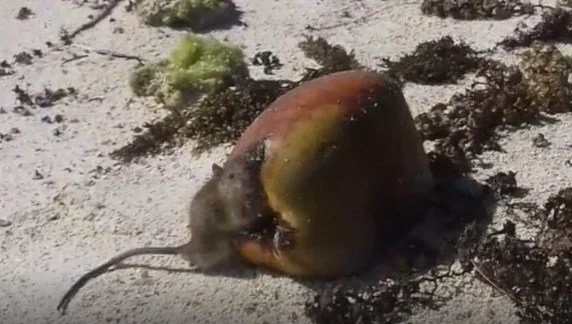Beyond Barrier
ENVIRONMENTAL NEWS FROM NEW ZEALAND AND AROUND THE WORLD
Pāteke do well in Abel Tasman National Park
Abel Tasman National Park is now seen as an important site for the survival of pāteke brown teal with 233 individuals released there since 2017. The birds breed after the first year of release and unbanded, wild bred ducks have been regularly sighted. Further releases are planned. Monitoring by Project Janszoon has found very low mortality amongst the birds, although there has been some road kill, also an issue on Aotea for this at-risk species.
Orange-fronted parakeet/kākāriki karaka bumper breeding
Juvenile orange fronted parakeet (kākāriki karaka) (Credit: Department of Conservation)
Kākāriki karaka is in the same threat category as the kākāpō and is our rarest mainland forest bird. It has one remaining mainland habitat, restricted to the beech forest of upland valleys in Lake Sumner Forest Park and Arthur’s Pass National Park.
With only 100-300 of these birds left in the wild, the captive breeding programme is providing a much-needed boost to the populations. This year was a bumper breeding season and despite the challenges of Covid-19, 2020 saw the release of over 30 young kākāriki karaka into Canterbury.
The species is one of New Zealand’s six species of parakeet/kākāriki. It’s thought the different species once occupied discrete niches on the mainland and may explain their current status. For example, after predators arrived, red-crowned parakeets, being ground-feeders, were the most vulnerable and disappeared from mainland forests first—and are now mainly found only on predator free islands, and on Aotea! Orange fronted parakeets, being birds of the high canopy, hung on longer, and still persist in beech forest of high valleys in Canterbury.
Ridge to reef - Tetiaroa Atoll
Introduced rats are a major problem on Pacific islands. The rats thrive on coconuts but also eat seabird and turtle eggs and hatchlings, as well as invertebrates, and plants (Credit: Tetiaroa Society)
The tiny Tetiaroa Atoll in French Polynesia is on a pathway to eradicating rats. Restoration on the motu will revive the terrestrial ecosystem to “near-pristine” condition, creating a major sanctuary for seabirds, sea turtles, and other native fauna and flora.
Extensive field research is planned by the Tetiaroa Society and Island Conservation to understand the impacts of invasive species removal on the environment. Tetiaroa will serve as a living laboratory to research and understand flows to seabirds, native vegetation, invertebrates, soil, and marine ecology. The research also aims to test if natural seabird colonies increase the health and resilience of coral reefs through fertilising effects of guano; and will “...complement traditional Polynesian knowledge and help raise awareness of the importance of restoring natural land-sea connections for biodiversity conservation and sustainable human development”.


